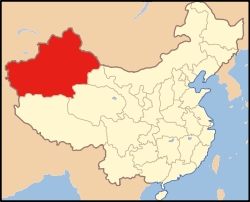Xinjiang Time

Xinjiang Time (Chinese: 新疆时间; pinyin: Xīnjiāng shíjiān), also known as Ürümqi Time (Chinese: 乌鲁木齐时间; pinyin: Wūlǔmùqí Shíjiān), is set due to its geographical location in the westernmost part of China.[1] The time offset is UTC+06:00 which is two hours behind Beijing, and is shared with Kyrgyzstan and most of Kazakhstan. It is one of the two time standards, together with Beijing Time, being used in parallel in Xinjiang, China.[2][3]
History
Xinjiang Time has been abolished and re-established multiple times, especially during the period of the 1970s and 1980s. In February 1986, the Chinese government had approved the use of Xinjiang Time (UTC+6) in Xinjiang for civil purposes, while railroad, aviation and telecommunication sectors were supposed to continue their operation on Beijing Time.[4][3] However, the decision had been rejected by the local ethnic Han population and some Han-dominated regional governments.[5]
Usage

Currently, the timezone used within Xinjiang is roughly split along the ethnic divide, with most ethnic Han population in the area following Beijing Time, and most ethnic Uyghur population as well as population of some other ethnics in the area following Xinjiang Time.[6] Some local authorities are now using both time standards side by side.[7][8] The coexistence of two timezones within same region has caused some confusion among local population especially when interracial communications occur, and whenever a time is mentioned, it is necessary to either explicitly make clear whether the time is Xinjiang Time or Beijing Time, or convert the time according to ethnicity of the target you are speaking to, in order to avoid confusion between the two time standards.[9][10][11] The double time standard is particularly observable in Xinjiang Television, which schedules its Chinese channel according to Beijing Time and its Uyghur and Kazakh channels according to Xinjiang Time.[12] Some ethnic Han population in Xinjiang might not be aware of the existence of the UTC+6 Xinjiang Time because of the language barrier.[13]
For Xinjiang population who are using Beijing Time instead of Xinjiang Time, they would schedule their activities two hours after ordinary time those daily activities are done in Eastern China to match the sunrise/sunset time, this is known as the work/rest time in Xinjiang, which is also referred to as Xinjiang Time or time difference between Xinjiang and mainland China.[14]
In 2014, Apple Inc. released an update to its iOS mobile operating system, which silently changed the default time for users in Xinjiang into Xinjiang Time. As some users in the area were using Beijing Time in their iOS before the update and set the alarm of their phones and tablets according to Beijing Time, the silent change caused some alarms to ring at a time later than expected, causing disruption in daily activity on the day after the changes.[15]
In 2018, it's reported by Human Rights Watch that an Uigur man was arrested and sent to a detention center because he set his watch to Xinjiang Time.[16]
IANA time zone database
The territory utilizing the Xinjiang Time is covered in the IANA time zone database by the following zones.
Columns marked with * are from the file zone.tab of the database.
| c.c.* | coordinates* | TZ* | comments* | Standard time | Summer time | Notes |
|---|---|---|---|---|---|---|
| CN | +4348+08735 | Asia/Urumqi | Xinjiang Time | UTC+06:00 | — | |
| CN | +3929+07559 | Asia/Kashgar | UTC+06:00 | — | Linked to Asia/Urumqi |
See also
References
- ↑ "2 节气、数九、昼长、乌鲁木齐时间". 新疆气象手册 (in Chinese). 新疆兴农网. 2011-02-22. Archived from the original on 2016-03-04. Retrieved 2017-06-24.
- ↑ "冷知识:"北京时间"的由来". 新华网. 3 November 2015. Retrieved 3 November 2015.
- 1 2 GUO, Qing-sheng (2001). "中国标准时制考" [A Study on the Standard Time Changes for the Past 100 Years in China] (PDF). China Historical Materials of Science and Technology (in Chinese). 22 (3): 269–280. 1000-0798(2001)03-0269-12. Retrieved 9 December 2016. 中国标准时制考
- ↑ "法定时与北京时间". 人民教育出版社. Archived from the original on 14 November 2006.
- ↑ 王力雄 (2007). 我的西域,你的東土:沒有人曾經,或可能如此解讀新疆與維吾爾人. 大塊出版. ISBN 9789862130117.
- ↑ "【讀書時間】在時間的悟透里跋涉或存在".
- ↑ Ingram, Ruth (September 2013). "Bending Time in Xinjiang".
- ↑ adilniyaz (2008-08-26). "作息时间". Archived from the original on 12 October 2014.
- ↑ 赫海威 (17 June 2016). "10点日出,半夜吃饭,在新疆用北京时间的烦恼". New York Times.
- ↑ 南香红 (2003-09-25). "【城市】乌鲁木齐:没有屋顶的博物馆". 南方周末. Archived from the original on 2016-12-21.
- ↑ Demick, Barbara (31 March 2009). "Clocks square off in China's far west". Los Angeles Times.
- ↑ 小康. "北京时间的概念". 西安同步电子科技有限公司.
- ↑ Luther Ma's note in IANA timezone database file
- ↑ "政协委员建议:调整新疆单位作息时间". 网易新闻中心. 2014-01-17.
- ↑ 盖煜 (2014-09-26). "乌鲁木齐市民反映:苹果系统升级后自动选择新疆时区". 凤凰资讯.
- ↑ Alexandra Ma (September 9, 2018). "China reportedly detained a man on terrorist charges because he set his watch 2 hours behind Beijing time". Business Insider.